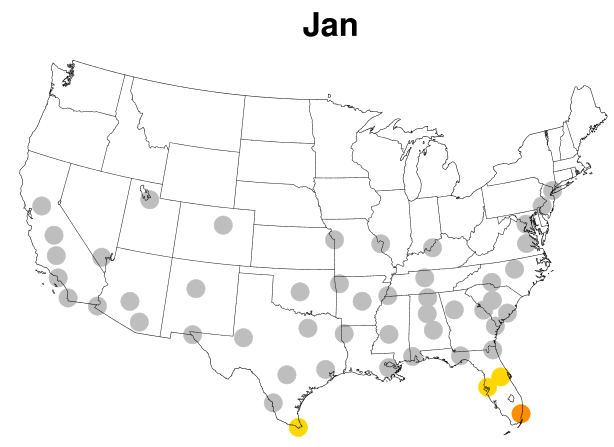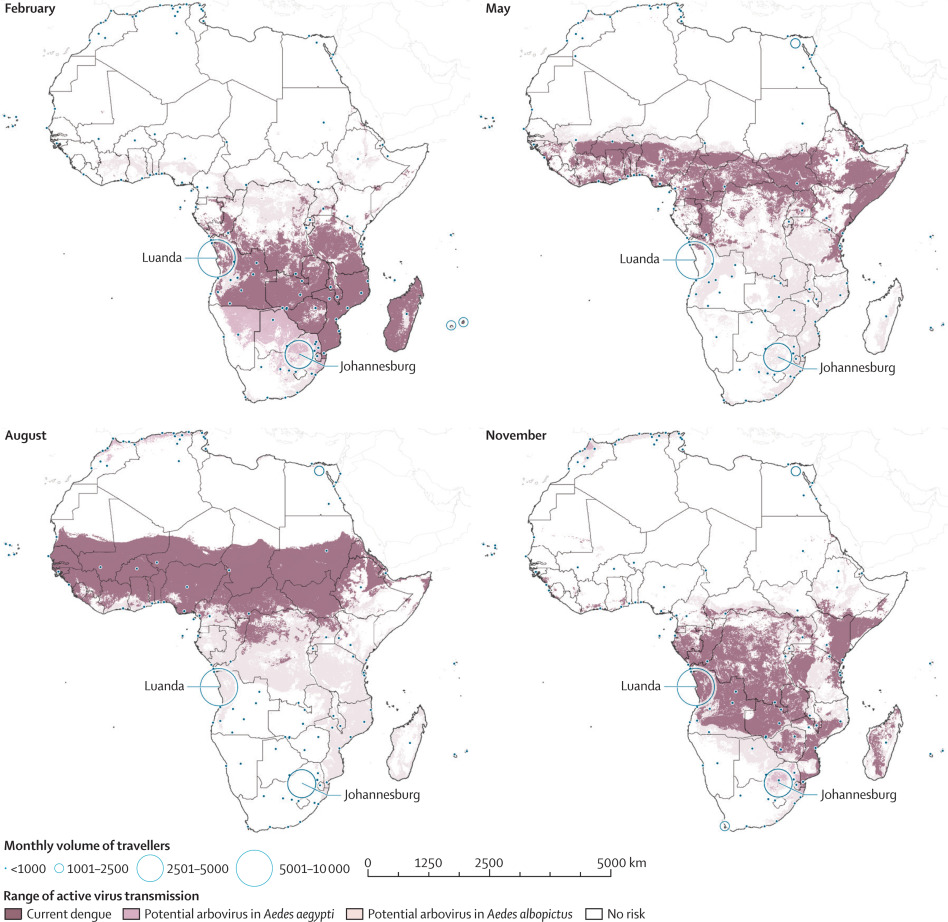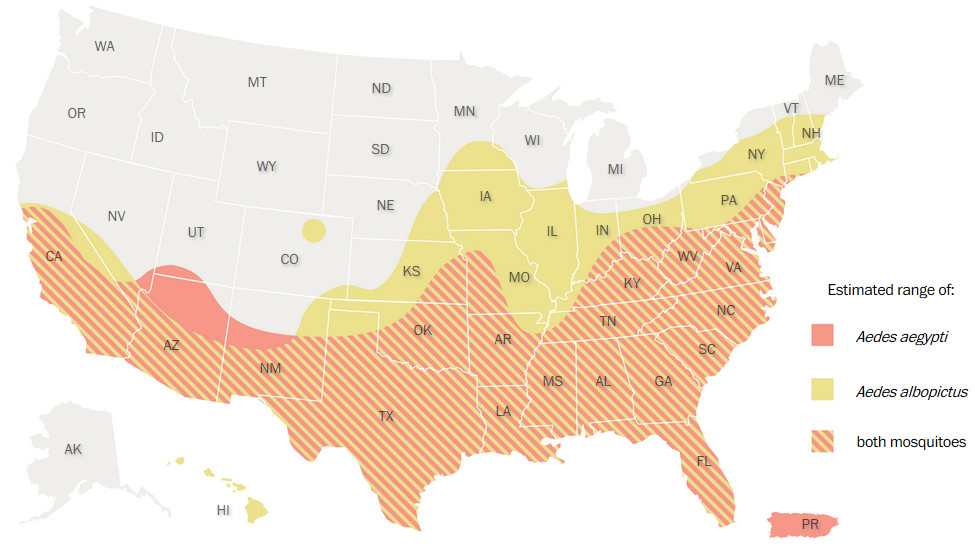Zika Virus: An Emerging Health Threat
Predicted distribution of Ae. aegypti
Predicted distribution of Ae. albopictus
Credit: Kraemer et al. eLife 2015;4:e08347
For decades, the mosquito-transmitted Zika virus was mainly seen in equatorial regions of Africa and Asia, where it caused a mild, flu-like illness and rash in some people. About 10 years ago, the picture began to expand with the appearance of Zika outbreaks in the Pacific islands. Then, last spring, Zika popped up in South America, where it has so far infected more than 1 million Brazilians and been tentatively linked to a steep increase in the number of babies born with microcephaly, a very serious condition characterized by a small head and brain [1]. And
Zika’s disturbing march may not stop there.
In a new study in the journal The Lancet, infectious disease modelers calculate that Zika virus has the potential to spread across
warmer and wetter parts of the Western Hemisphere as local mosquitoes
pick up the virus from infected travelers and then spread the virus to
other people [2]. The study suggests that Zika virus could eventually
reach regions of the United States in which 60 percent of our population
lives. This highlights the need for NIH and its partners in the public
and private sectors to intensify research on Zika virus and to look for
new ways to treat the disease and prevent its spread.
Zika virus infection can be spread by yellow fever mosquitoes (Aedes aegypti), and experimental evidence suggests the virus also can be transmitted by Asian tiger mosquitoes (Aedes albopictus). Aedes mosquitoes – already
known for transmitting other viral illnesses, such as dengue and
chikungunya – have a wide and expanding global distribution, including in
the United States [3]. To predict places around the world where Zika
virus might spread as people infected in the Brazilian outbreak come
into contact with biting Aedes mosquitoes, the NIH-supported
research team, led by Kamran Khan of St. Michael’s Hospital, Toronto,
first mapped the global distribution of Aedes mosquitoes along
with the climate conditions the researchers deemed favorable to the
spread of Zika virus. They then layered onto this map the final
destinations of travellers who might have been exposed to Zika virus
before departing Brazil from September 2014 to August 2015.
During the year, 9.9 million travelers left 146 Brazilian airports
near areas known to be conducive to Zika virus transmission for
destinations around the world. North and South American countries were
the most-popular destinations (representing 65 percent of travelers)
followed by those in Europe (27 percent) and Asia (5 percent). The
most-popular travel spot was the United States, with more than 2.7
million people making the trip.
According to the researchers’ calculations, about 200 million
Americans – more than 60 percent of the population—reside in areas of the
United States that might be conducive to the spread of Zika virus during
warmer months through biting mosquitoes, including areas along the East
and West Coasts and much of the Midwest. In addition, another 22.7
million people live in humid, subtropical parts of the country that
might support the spread of Zika virus all year round, including
southern Texas and Florida. Already, there are reports of local spread
of the virus within Puerto Rico and of travelers returning to the U.S.
with the Zika infection.
With all this in mind, it is now critically important to confirm,
through careful epidemiological and animal studies, whether or not a
causal link exists between Zika virus infections in pregnant women and
microcephaly in their newborn babies. Brazilian health authorities made
the initial connection between the virus and birth defects, primarily
because the increase in microcephaly seemed to emerge a few months after
the introduction of Zika virus into Brazil. Thousands of cases of
microcephaly have now been reported and the Brazilian health ministry
has confirmed the presence of Zika virus in tissue samples and amniotic
fluid collected from a small number of affected children or their
mothers [1]. While the U.S. Centers for Disease Control and Prevention
(CDC) has obtained similar findings, it remains unclear what other
factors might increase risks to the developing fetus [4].
In November, health authorities in French Polynesia also reported an
unusual increase of central nervous system malformations in fetuses and
infants that seemed to coincide with the Zika outbreak there. And, last
week, came news reports of the first child born in the U.S. with
microcephaly possibly linked to Zika. The child’s mother had lived in
Brazil during her pregnancy before moving to Oahu, Hawaii [5]. As an
additional concern, there are reports in French Polynesia and Brazil of a
possible connection between Zika infection and Guillain-Barré syndrome,
a mysterious condition in which the immune system attacks part of the
peripheral nervous system [1].
With no vaccine or treatment currently available to prevent or treat
Zika infection, the best way for individuals—and pregnant women in
particular—to protect themselves is to avoid traveling to places where
Zika is known to be spreading. If an individual has to live or work in
such a region, CDC recommends strict precautions to avoid mosquito
bites, including wearing protective clothing, using insect repellants,
and sleeping in rooms with window screens or air conditioning. Though
still unproven, the link between Zika infection and microcephaly has
also prompted CDC to issue interim guidelines recommending that women
who are pregnant or planning to become pregnant consider postponing
travel to areas where Zika virus has spread. This frequently updated
list currently includes Puerto Rico, Mexico, and 20 other countries in
South America, Central America, the Caribbean, the Pacific islands, and
Africa [6].
Many important questions remain about Zika. But, as Anthony Fauci,
director of NIH’s National Institute for Allergy and Infectious
Diseases, noted in his recent New England Journal of Medicine
essay, one thing is very clear: far more research into Zika virus and
its interactions with its mosquito, human, and non-human primate hosts
is urgently needed [7]. For instance, it will be important to determine
how readily Asian tiger mosquitoes, which can tolerate relatively cold
temperatures, spread Zika virus.
The scientific community must also step up its efforts to develop
innovative approaches against the virus, and that’s certainly happening
at NIH. With NIAID taking the lead, research is underway to understand
better Zika’s effects on the body, to develop diagnostic tests to
identify the virus rapidly in people, and to ramp up testing of
therapeutics that might be effective. Importantly, NIAID researchers
already are working on vaccine candidates to prevent Zika virus from
infecting people. All of this work is a compelling example of NIH
mobilizing swiftly in the face of a rapidly emerging infectious disease,
and seeking the research answers that Americans and people across the
globe need.
References:
[1] Rapid risk assessment: Zika virus epidemic in the Americas: potential association with microcephaly and Guillian-Barre syndrome. European Centre for Disease Prevention and Control. 10 December 2015.
[2] Anticipating the international spread of Zika virus from Brazil.
Bogoch II, Brady OJ, Kraemer MU, German M, Creatore MI, Kulkarni MA,
Brownstein JS, Mekaru SR, Hay SI, Groot E, Watts A, Khan K. Lancet. 2016
Jan 14. pii: S0140-6736(16)00080-5.
[3] The global distribution of the arbovirus vectors Aedes aegypti and Ae. albopictus.
Kraemer MU, Sinka ME, Duda KA, Mylne AQ, Shearer FM, Barker CM, Moore
CG, Carvalho RG, Coelho GE, Van Bortel W, Hendrickx G, Schaffner F,
Elyazar IR, Teng HJ, Brady OJ, Messina JP, Pigott DM, Scott TW, Smith
DL, Wint GR, Golding N, Hay SI. Elife. 2015 June 30;4:e08347.
[4] CDC Telebriefing: Zika Virus Travel Alert. Centers for Disease Control. 15 January 2016.
[5] Hawaii baby born with small head had prior Zika infection. CNN. 19 January 2016.
[6] Interim Guidelines for Pregnant Women During a Zika Virus Outbreak — United States, 2016. Centers for Disease Control. 19 January 2016.
[7] Zika Virus in the Americas – Yet Another Arbovirus Threat. Fauci AS, Morens DM. N Engl J Med. 2016 Jan 13. [Epub ahead of print]
Links:
Zika Virus Infection and Pregnancy (CDC)
Kamran Khan (St. Michael’s Hospital, Toronto)
Fogarty International Center (NIH)
NIH Support: Fogarty International Center
Related posts:
– All the known cases of Zika virus in the World
– Where in the World is Zika virus?
– Mapping the Zika Virus
– The Zika virus
– Zika virus threatens US from abroad








